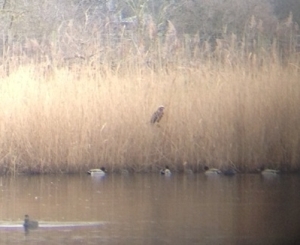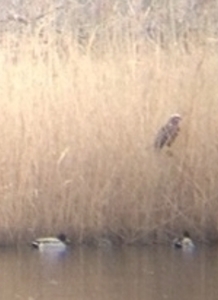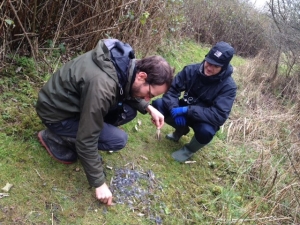Crossness showed with impeccable timing, just what makes it one of the very best wildlife sites in Bexley today, as Karen Sutton – recently promoted to Biodiversity Team Manager for Thames Water – showed two new members of her team around the site today (Feb 10th). These were Ian Crump, the new Biodiversity Field Officer; and Peter Beckenham, Beckton Nature Reserve Manager (who is also involved with the LWT reserve at Braeburn Park).
Leading the parade along the ‘green carpet’ at this Erith Marshes location was a Marsh Harrier flying at the eastern end of the site, before roosting low down in the reeds that fringe the Great Breach Lagoon. Karen captured the following shot with her mobile phone camera through a pair of binoculars, hence the indifferent picture quality – but the brown colouration and paler head makes the identification clear enough.
The Marsh Harrier is a raptor that was wiped out in the UK by the end of the 19th century due to persecution and drainage of its habitat. It has been making a slow comeback since the 1950s and has become reasonably frequent over at Rainham, but is still a rare sight in our Borough – illustrating why we must fight to protect, restore and enlarge these wild places, not just for what is there already, but for what was and what could be again.
In addition to lots of gadwall, wigeon, teal and shoveler scattered across the reserve, they were also fortunate to see a kingfisher flying up the Great Breach Dyke, shortly before watching a water vole leisurely feeding on the bank. A kestrel was seen in flight, and the song thrush kill of a sparrowhawk was found in the Protected Area of the reserve. Cetti’s warblers were calling along the whole route and large flocks of dunlin on the river finished the walk off nicely.




Great attempt through binoculars, maybe Thames water should get you a good camera and lense suitable for the job, keep up the good work Karen!